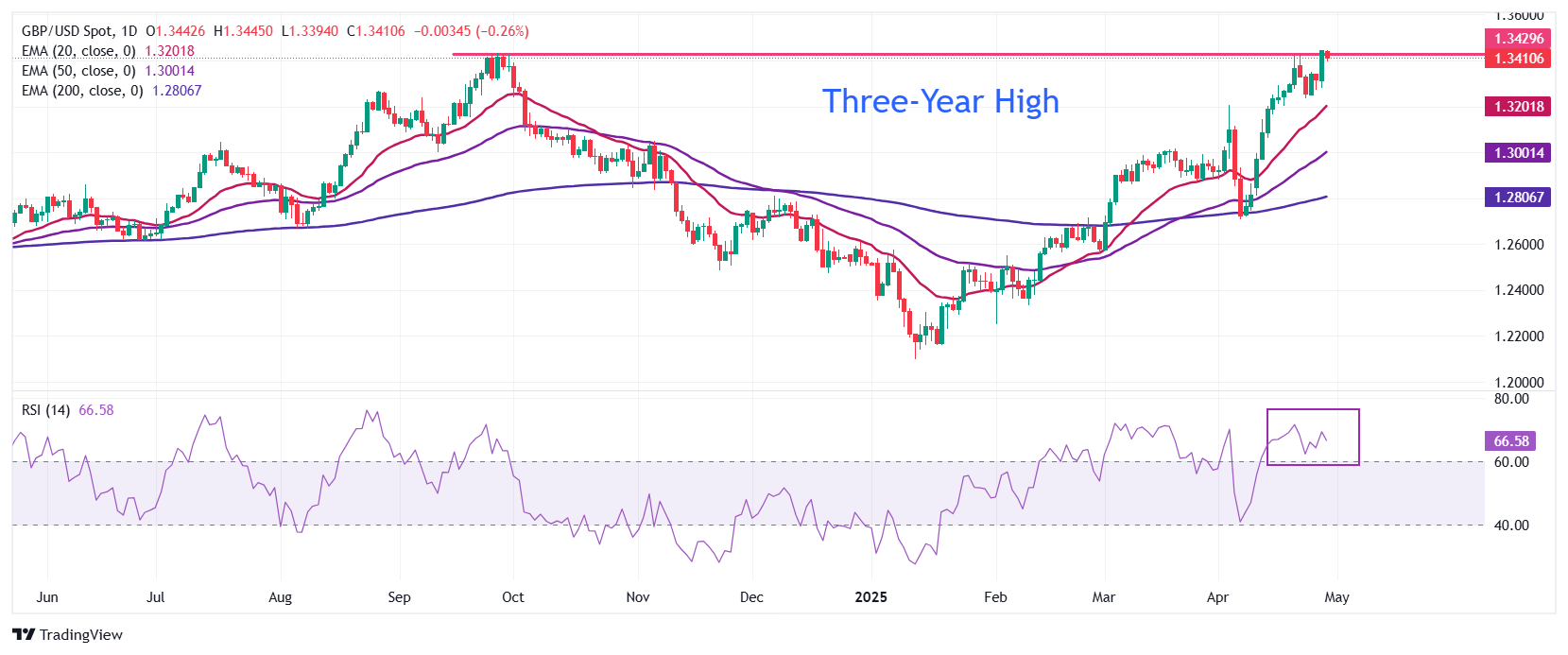- The Pound Sterling retraces against the US Dollar to near 1.3400 ahead of a slew of US economic data, notably the Q1 GDP release.
- The US economy is expected to have expanded at a slight pace of 0.4% in the January-March period.
- BoE Greene expects Trump’s tariff policy to be net disinflationary for the economy.
The Pound Sterling (GBP) corrects to near 1.3400 against the US Dollar (USD) in Wednesday’s European session from its fresh three-year high of 1.3445 posted on Tuesday. The GBP/USD pair drops slightly as the US Dollar (USD) ticks higher ahead of a string of top-tier key United States (US) economic data, notably the preliminary Q1 Gross Domestic Product (GDP) data release in the North American session.
The US Bureau of Economic Analysis (BEA) is expected to report that the economy grew at a slower pace of 0.4% on an annualized basis, much lower than the prior reading of 2.4%. Economists have anticipated a moderate GDP growth on expectations of a slowdown in economic activity in the face of hefty tariffs imposed by US President Donald Trump earlier this month.
Trump’s sweeping additional tariffs on its trading partners have led to an increase in global economic uncertainty, including in the US. Theoretically, Trump’s protectionist policies should prompt domestic industry to ramp up their production to offset lower imports, but ever-changing headlines from the White House over import duties have forced them to put their expansion plans on hold.
Additionally, investors will focus on the Q1 Employment Cost Index, ADP Employment Change data for April, and the Personal Consumption Expenditure Price Index (PCE) data for March. The Employment Cost Index, which measures change in total employee cost for a company, is expected to have risen steadily by 0.9%. In the US private sector, employers are expected to have hired 108K fresh workers in April, significantly lower than 155K in March.
Meanwhile, the core PCE inflation data, which is the Federal Reserve’s (Fed) preferred inflation gauge, is expected to have grown by 2.6%, slower than the 2.8% increase seen in February.
Signs of easing job growth and cooling inflationary pressures would boost market expectations that the Fed could reduce interest rates in the June policy meeting. According to the CME FedWatch tool, there is a 65% chance that the central bank will reduce interest rates in June. For the May policy meeting, traders are almost fully pricing in that the Fed will keep interest rates unchanged in the range of 4.25%-4.50%.
Fed officials have indicated that interest rates should remain at their current level until they get clarity on how new economic policies by Donald Trump shape the economic outlook. On Tuesday, Trump criticized Fed Chair Jerome Powell again for not lowering interest rates, while commemorating his first 100 days in office. Trump didn’t mention Powell explicitly, but his comments and past record with him indicated so.
“You’re not supposed to criticize the Fed, you’re supposed to let him do his own thing, but I know much more than he does about interest rates, believe me,” Trump said.
Daily digest market movers: Pound Sterling trades lower against its peers
- The Pound Sterling underperforms its peers in European trading hours on Wednesday as traders have become increasingly confident that the Bank of England (BoE) will reduce interest rates by 25 basis points (bps) in its monetary policy meeting on May 8. BoE dovish bets have escalated amid fears that the new tariff policy by the US will ease inflationary pressures and weaken United Kingdom (UK) economic growth.
- BoE policymaker Megan Greene said that the potential trade war would be “net disinflationary” for the UK economy, in a discussion with the Atlantic Council think tank on Friday. Greene warned about shockwaves in the job market in the face of an increase in employers’ contribution to social security schemes to 15% from 13.8%, which has become effective this month.
- Last week, BoE Governor Andrew Bailey stressed the need to consider trade war risk by the central bank. “We do have to take very seriously the risk to growth, Bailey said at the sidelines of the International Monetary Fund’s (IMF) Spring Meetings in Washington.
- This week, the UK economic calendar has nothing important to offer. Therefore, external forces would be the key driver of the British currency.
- The Pound Sterling has remained underpinned against the US Dollar amid elevated uncertainty over the US-China trade war. Washington wants China to initiate trade discussions with them, given its significant reliance on their exports to the US. “I believe that it’s up to China to de-escalate, because they sell five times more to us than we sell to them, Bessent said in an interview on CNBC’s Squawk Box on Monday. Meanwhile, Beijing has vowed to fight the tariff war to protect its interests and dignity.
Technical Analysis: Pound Sterling stays above all key EMAs

The Pound Sterling retraces to near 1.3400 against the US Dollar from the three-year high of 1.3445. However, the overall outlook of the pair remains bullish as all short-to-long Exponential Moving Averages (EMAs) are sloping higher.
The 14-day Relative Strength Index (RSI) rebounds after cooling down to 60, currently at around 65, indicating a resurgence in the upside trend.
On the upside, the round level of 1.3600 will be a key hurdle for the pair. Looking down, the April 3 high around 1.3200 will act as a major support area.
Pound Sterling FAQs
The Pound Sterling (GBP) is the oldest currency in the world (886 AD) and the official currency of the United Kingdom. It is the fourth most traded unit for foreign exchange (FX) in the world, accounting for 12% of all transactions, averaging $630 billion a day, according to 2022 data.
Its key trading pairs are GBP/USD, also known as ‘Cable’, which accounts for 11% of FX, GBP/JPY, or the ‘Dragon’ as it is known by traders (3%), and EUR/GBP (2%). The Pound Sterling is issued by the Bank of England (BoE).
The single most important factor influencing the value of the Pound Sterling is monetary policy decided by the Bank of England. The BoE bases its decisions on whether it has achieved its primary goal of “price stability” – a steady inflation rate of around 2%. Its primary tool for achieving this is the adjustment of interest rates.
When inflation is too high, the BoE will try to rein it in by raising interest rates, making it more expensive for people and businesses to access credit. This is generally positive for GBP, as higher interest rates make the UK a more attractive place for global investors to park their money.
When inflation falls too low it is a sign economic growth is slowing. In this scenario, the BoE will consider lowering interest rates to cheapen credit so businesses will borrow more to invest in growth-generating projects.
Data releases gauge the health of the economy and can impact the value of the Pound Sterling. Indicators such as GDP, Manufacturing and Services PMIs, and employment can all influence the direction of the GBP.
A strong economy is good for Sterling. Not only does it attract more foreign investment but it may encourage the BoE to put up interest rates, which will directly strengthen GBP. Otherwise, if economic data is weak, the Pound Sterling is likely to fall.
Another significant data release for the Pound Sterling is the Trade Balance. This indicator measures the difference between what a country earns from its exports and what it spends on imports over a given period.
If a country produces highly sought-after exports, its currency will benefit purely from the extra demand created from foreign buyers seeking to purchase these goods. Therefore, a positive net Trade Balance strengthens a currency and vice versa for a negative balance.
indicated

